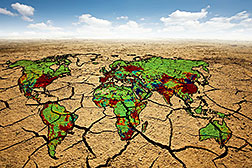- Number 422 |
- September 15, 2014
Water scarcity and climate change through 2095

Future water scarcity may pose a significant
challenge to our ability to adapt to or
mitigate climate change.
What will a global map of the availability or scarcity of water look like in 2095? Radically different, according to scientists at DOE’s Pacific Northwest National Laboratory, depending on the type and the stringency of the climate mitigation policies chosen to reduce carbon pollution. Climate mitigation policies that increase the growth of certain water-hungry biofuels may exacerbate water scarcity. Limited water resources could severely restrict emissions mitigation and climate adaptation.
In a first-of-its-kind comprehensive analysis, the team enhanced the Global Change Assessment Model to assess the impact of changing water supplies and demands that stem from a simultaneously evolving human population, economic system, technology, and climate. When they incorporated water use and availability in this computational engine and ran scenarios of possible climate mitigation policy targets, they found that without any climate policy to curb carbon emissions, half the world will be living under extreme water scarcity.
"All high-resolution global integrated assessment models that contributed to the construction of the representative concentration pathways or RCPs used by all participating climate models in the IPCC Fifth Assessment Report lack any representation of water systems," said Dr. Mohamad Hejazi, lead author and climate scientist at PNNL, working at the Joint Global Change Research Institute (JGCRI). "This implicitly assumes that emissions mitigation will be unaffected by water scarcity. Yet, we found that water is a significant component of our climate's future, even if societies deploy mitigation policies."
This study marks an important milestone in closing the water system in an integrated assessment modeling framework for the first time. The team is working on extending the framework to reconcile water demands and supplies at the basin scale and to dynamically model the consequences of water scarcity on energy and land-use decisions.
The DOE Office of Science, Biological and Environmental Research Program, Integrated Assessment Research Program (IARP) and Earth System Modeling Program supported this research. Evergreen computing resources, which are also supported by the IARP, were used at the PNNL's JGCRI at the University of Maryland in College Park. JGCRI is a partnership between PNNL and the University of Maryland.[Kristin Manke, 509.372.6011,
kristin.manke@pnnl.gov]
